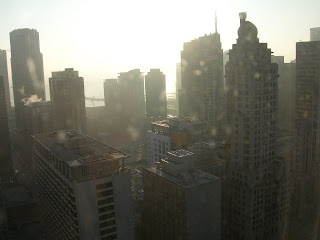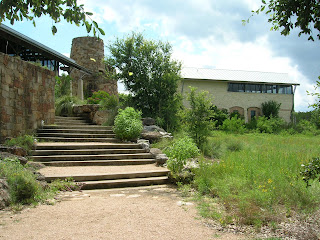April 7, 2007, Houston Chronicle
By R. GREGORY TURNER
YOU never know what you'll learn about your city on a golf outing. When several of my brothers recently visited from out of state to indulge in a golf weekend, we spent a great deal of time watching the suburban cityscape rush by as we traversed the vast metropolitan area of Houston on our way to the courses. After one long trek in the van, my youngest brother made an observation that at once identified a problem with our sprawling region — a problem shared with most other American cities— and at the same time revealed the solution. We spent the rest of the weekend laughing about "the three mile loop."
This "loop" was not a roadway in the sense of our West Loop. Rather, it referred to the visual loop that the recurring suburban landscape created as we passed through it. Seemingly every third mile we saw the same school building, then the same church, then the same shopping center, then the same ... well, you get the idea. If it weren't for our arrival at the golf courses, we all would have been convinced that we hadn't actually gone anywhere. The supposed repetition and monotony of urban sprawl has been a long standing joke, dating back to Gertrude Stein's famout remark about Oakland, "There is no there there." What I found intriguing about the three mile loop, however, is the concept it offers to create significant degrees of visual interest in our low-rise city. For the three mile loop reveals certain qualities about our surroundings that, with imagination, can be exploited to enhance the experience of our urban landscape.
First, what might begin as repetition can instead become rhythm. The 1980 film, Koyaanisqatsi, celebrated otherwise overlooked rhythms in day-to-day events by changing the speeds at which they are observed. My brother's revelation similarly occurred because his unfamiliarity with our city's topography permitted him to make observations that we, hurrying about our busy lives, find it too easy to overlook.
For example, he noticed the pattern that significant suburban structures establish, particularly modern school buildings. They rise above retail and residential buildings; oftentimes they extend the equivalent of several city blocks. Imagine if school districts conceived of these structures not as individual schools, but as pieces of recurring facades that established themes along roadways. Imagine if some of these façades aggressively confronted the street, establishing themselves as landmarks able to be seen from greater distances, creating periodic vistas rather than receding behind seas of parked cars as they do now. Such an approach could fashion dramatic rhythmical elements along our thoroughfares.
Next there is distinctiveness. There are many substantial structures in the urban landscape that may be well-designed for their specific purpose, and may introduce rhythm in the landscape. However, the pattern they establish easily begets boredom if they are indistinguishable from other structures of similar purpose and scale — in other words, if they are not distinctive. Buying a standard design and repeating it on multiple sites may effect some cost savings that taxpayers claim to like, but the outcome of this rubber stamp approach is that one can drive many, many miles through several school districts, without ever knowing where one ends and the other begins. This, I suppose, is perfectly acceptable if one's community envisions itself as undifferentiated from others.
Imagine instead that individual school districts seized the opportunity afforded by their expansive building programs to transform their surroundings and create a sense of place defined by an architecture distinctive to them and them only. Taking the step of making themselves recognizable could set as powerful an example regarding what "recognized" means as SAT scores or state awards do.
Finally, non-thematic elements — those that burst forth seemingly at random — introduce variety, spontaneity, and usually orientation to the visual landscape. Perhaps the most prominent example is our major freeway system. The Texas Department of Transportation, through its Green Ribbon program, has come to understand the power of its right of way to elevate the experience of those it encounters. The developing Interstate 10 project demonstrates how a change in conception of a freeway as an urban micro-environment instead of a mere means of transportation vastly enriches the visual world, and enhances as well the properties it abuts. Granted, it cost an extra one-half of one percent but this is a relative pittance to devote to projects that have far greater impact on our environment than the tallest skyscrapers.
Besides the freeways, the three mile loop's other non-thematic interruptions appear to be the bayou that it sometimes intersects, the golf course or park that occasionally surprise, or the distinctive planned community entrance monument. While our flood control districts have come to see the asset value of their drainage channels as parkland amenities, imagine also if their easements were flared to much wider dimensions where they cross major roadways, enabling the creation of periodic "jungles." And what if golf courses and parklands, instead of snaking between rows of houses, stretched along roadways for some distance, providing not only open space but views of activity as well?
Some of this is already occurring in the city's northwestern stretches. There are many opportunities for creative thinking by both public and private entities in considering how to address the interface between their own domains and the roadways on which we all travel.
In the last analysis, vision and imagination can leverage the monies being lavished on necessary projects, enabling transformative solutions to what might otherwise be considered routine design problems (witness TxDOT). Commitments to leave distinctive imprints on our communities can convert the apparent monotony of our rapidly developing cityscape into one full of rich patterns and pleasant surprises. I can only hope that on my next golf outing my brother wonders where his loop went.
Turner is president of Turner Partners Architecture, LP, in Houston. The firm specializes in institutional and corporate projects throughout Southeast Texas.
 Keynote - Bill Clinton: Impeached Ex-U.S. President
Keynote - Bill Clinton: Impeached Ex-U.S. President Keynote - Paul Hawken: Inspiration/Genius
Keynote - Paul Hawken: Inspiration/Genius Andrés and I snuck on the Hydrogen Bus with the CNN cameras
Andrés and I snuck on the Hydrogen Bus with the CNN cameras View from The Marriott on the Magnificent Mile: 45th Floor
View from The Marriott on the Magnificent Mile: 45th Floor
 The beautiful Chicago River
The beautiful Chicago River Cloud Gate at Millennium Park
Cloud Gate at Millennium Park



 Frank Gehry's Jay Pritzker Pavilion
Frank Gehry's Jay Pritzker Pavilion The Lurie Garden
The Lurie Garden
 The Crown Fountain
The Crown Fountain  ...and of course I found a Henry Moore: Large Interior Form
...and of course I found a Henry Moore: Large Interior Form
 Keynote - Bill Clinton: Impeached Ex-U.S. President
Keynote - Bill Clinton: Impeached Ex-U.S. President Keynote - Paul Hawken: Inspiration/Genius
Keynote - Paul Hawken: Inspiration/Genius Andrés and I snuck on the Hydrogen Bus with the CNN cameras
Andrés and I snuck on the Hydrogen Bus with the CNN cameras View from The Marriott on the Magnificent Mile: 45th Floor
View from The Marriott on the Magnificent Mile: 45th Floor
 The beautiful Chicago River
The beautiful Chicago River Cloud Gate at Millennium Park
Cloud Gate at Millennium Park



 Frank Gehry's Jay Pritzker Pavilion
Frank Gehry's Jay Pritzker Pavilion The Lurie Garden
The Lurie Garden
 The Crown Fountain
The Crown Fountain  ...and of course I found a Henry Moore: Large Interior Form
...and of course I found a Henry Moore: Large Interior Form

 Leader of the Pack
Leader of the Pack



 Eco-teacho's Canoeing 101
Eco-teacho's Canoeing 101 Who pulled the plug?
Who pulled the plug?









 Lady Bird Johnson Wildflower Center
Lady Bird Johnson Wildflower Center Mega-tank!
Mega-tank! "Hello, up there!"
"Hello, up there!" "Hello, down there!"
"Hello, down there!"


 City Limits
City Limits

 Our B.M. (Ben Milam)
Our B.M. (Ben Milam) Gettin' a little mud on the tires
Gettin' a little mud on the tires Me and Bertha
Me and Bertha
















